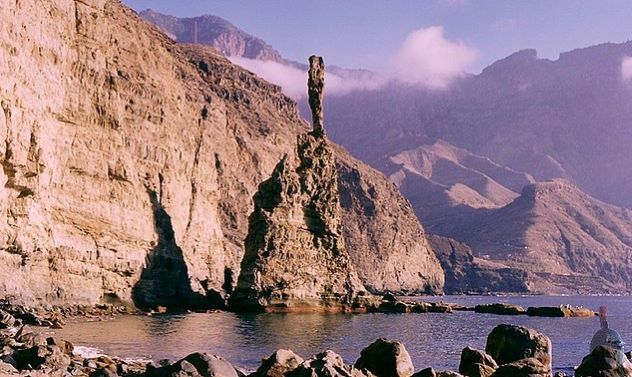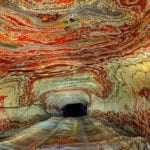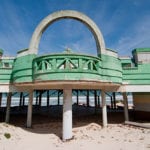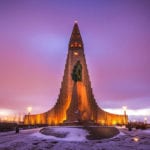 Humans
Humans  Humans
Humans  Movies and TV
Movies and TV 10 Holiday Movies Released at Odd Times of the Year
 Politics
Politics 10 Countries Where Religion and Politics Are Inseparable
 Weird Stuff
Weird Stuff 10 Freaky Times When Famous Body Parts Were Stolen
 Miscellaneous
Miscellaneous 10 Interesting Things Manufacturers Stopped Making and Why
 Gaming
Gaming 10 Funny Tutorials in Games
 History
History 10 Fascinating Little-Known Events in Mexican History
 Facts
Facts 10 Things You May Not Know about the Statue of Liberty
 Movies and TV
Movies and TV 10 Movie Adaptions That Brought Popular Songs to Life
 Health
Health 10 Miraculous Advances Toward Curing Incurable Diseases
 Humans
Humans 10 One-of-a-kind People the World Said Goodbye to in July 2024
 Movies and TV
Movies and TV 10 Holiday Movies Released at Odd Times of the Year
 Politics
Politics 10 Countries Where Religion and Politics Are Inseparable
Who's Behind Listverse?

Jamie Frater
Head Editor
Jamie founded Listverse due to an insatiable desire to share fascinating, obscure, and bizarre facts. He has been a guest speaker on numerous national radio and television stations and is a five time published author.
More About Us Weird Stuff
Weird Stuff 10 Freaky Times When Famous Body Parts Were Stolen
 Miscellaneous
Miscellaneous 10 Interesting Things Manufacturers Stopped Making and Why
 Gaming
Gaming 10 Funny Tutorials in Games
 History
History 10 Fascinating Little-Known Events in Mexican History
 Facts
Facts 10 Things You May Not Know about the Statue of Liberty
 Movies and TV
Movies and TV 10 Movie Adaptions That Brought Popular Songs to Life
 Health
Health 10 Miraculous Advances Toward Curing Incurable Diseases
Ten Beautiful Natural Wonders That No Longer Exist
Our visual panoramas of our countries’ and territories’ terrains and vistas shape our sense of belonging, yet the world is always transforming. Tectonic activity, air currents, moisture, heat, and people all work together to reshape what we accept as familiar terrain, stripping away immense ravines, creating new land with steaming molten rock, and moving the paths of great river systems.
Large numbers of famous attractions all around the world have dramatically changed shape—or, worse, vanished—over the last five decades. The famous Darwin’s Arch in the Galápagos Islands disintegrated into the ocean in 2021, joining a multitude of other natural wonders that have been lost to time. Serving as a reminder that our world is constantly changing, here are a few of the world’s natural wonders that have been lost forever.
Related: 10 Beautiful And Bizarre Natural Wonders
10 Chacaltaya Glacier, Bolivia
Glaciers all over the world have shrunk rapidly in recent years, with several disappearing completely. In South America, climate change, specifically increased temperatures, steadily increasing humidity, and changes in rainfall patterns, are being blamed for the extremely rapid demise of the Andean glaciers. In the tropical Andes region, the average annual temperatures have been steadily rising at a rate of 0.33°C (0.6°F) every ten years since the 1990s. The accompanying high humidity levels also significantly contribute to the reduction of the Andean glaciers by causing the ice to melt instead of being turned into vapor via a process scientists call sublimation.
The Chacaltaya glacier, located about 20 kilometers (12 miles) to the northeast of La Paz, managed to lose over 60% of its mass from the 1940s to the 1980s and over 90% at the turn of the century. At that point, scientists predicted that the Chacaltaya glacier could very well disappear completely by 2015. However, rapid temperature increases due to global warming hastened the process, and the glacier vanished in 2009, leaving the slopes once overwhelmed with skiers dry and empty.[1]
9 Azure Window, Malta
In Malta, the Azure Window was carved into Gozo Island’s limestone cliffs over hundreds of years. It withstood thousands of storms during its existence, but on March 8, 2017, it was pummelled into the sea forever during the worst storm of the season. Before its collapse, the instantly recognizable site in Dwejra Bay was one of Malta’s most popular tourist spots. In fact, most of us saw it during the Game of Thrones series.
However, four years later, it seems quite possible that the Maltese people’s shared broken heart might very well soon be patched up. The renowned architect Svetozar Andreev, in collaboration with the designer Elena Britanishskaya, has created a phenomenal concept for the restoration of this long-time historical landmark in the form of a massive artwork. The two Russian artists have already submitted the conceptual design to the relevant authorities. The remarkable project has already crept into the hearts of the locals who refer to it as the “The Heart of Malta.”[2]
8 Hillary Step on Mount Everest, Nepal
Since the day during 2017 when climbers announced that the “Hillary Step” vanished, the status of the rocky outcrop, christened after Everest’s famous summiteer Sir Edmund Hillary, has been a source of considerable controversy. Edmund Hillary and the Sherpa Tenzing Norgay successfully reached the summit after taking the steep step to the top, becoming the first climbers in our known history to reach the summit in 1953. After that first prolific climb, all climbers attempting to summit by way of the southern route have been using ropes to best the fearsome challenge before they reach the top, where they have to swing one leg over the “saddle” to get to the other side.
Experts believe that a 2015 earthquake may have dislodged the vertical outcropping. However, the Nepalese government maintains that it is just buried in snow—but they have admitted that all guides have been forbidden from discussing the Hillary Step due to the matter’s sensitive nature. As of 2017, numerous before and after photographs showing an obvious lack of the rocky protrusion have circulated. Despite the government’s claims, climbers have already started to refer to the Hillary staircase rather than the Hillary step when discussing the area.[3]
7 Slims River, Canada
In the early summer of 2017, an entire river in the Yukon territory of Canada vanished within a mere four days. The trigger to the event was the rapid retreat of the enormous Kaskawulsh Glacier, which redirected the meltwater from the Slims River toward another river. According to scientists, the event marked the first incidence of “river piracy” in contemporary times. These shifts are also effectively reducing the size of Kluane Lake, the Yukon’s largest lake.
The Slims River’s demise has had an immediate and profound influence on the environment, disbursing fish stocks, completely changing the composition of neighboring lakes, and causing a rash of novel dust storms to hit the province. Many other glacial-fed rivers in the area, such as those that provide water and hydroelectric power to higher populated areas, may also be impacted. Geologists describe it as a previously unseen side-effect of global warming. This could also come to occur at other glacial-fed rivers throughout the world, placing river-dependent communities and environments at grave risk moving forward.[4]
6 Sequoia Tunnel Tree, California
The glorious Pioneer Cabin “tunnel tree” in Calaveras Big Trees State Park in California was one of several colossal trees cut in the 1800s to boost California’s tourist industry. By the time it toppled over in 2017, it was California’s last giant sequoia featuring a drive-through arched doorway in its trunk. Although the true age of the Pioneer Cabin tree is unknown, several Sequoia trees within the area are well over 1,000 years old. And even older trees (dating back more than 3,000 years) have been discovered in nearby Yosemite National Park.
Only a few Sequoias were “tunneled-through” to serve the tourism purpose, the most famous of which was Yosemite’s Wawona Tree, estimated to have been around 2,100 years old when a storm brought it down in 1969. Today, the only lingering sequoia tree tunnels that can be found are either made up of stacked logs or trees that have long since died.
However, some drive-through “tunnel-trees” still exist. You can still visit three coastal Redwood trees (which are even longer but slimmer than the Sequoias) with tunnels cut through them. Although all three are owned by private companies, according to the Forest Service, they still allow cars to pass through and make for an incredible photo opportunity should anyone be passing through Northern California.[5]
5 God’s Finger, Spain

The symbol of Gran Canaria, El Dedo de Dios, also known as “God’s Finger,” used to be a 98-foot-tall rock formation to the north of Gran Canaria, an island in the chain that makes up the Canary Islands. The rock’s distinct shape has inspired numerous artists over the years, and many believe that the famous writer Domingo Doreste was the first to pen its name.
In November 2005, tropical storm Delta created havoc all along the coastline, and the ensuing immense waves finally toppled the top part of the 300,000-year-old rock feature. After “God’s Finger” was destroyed, a team of experts investigated the possibility of rebuilding the famous landmark. However, the majority advised against its restoration and outlined a plan to conserve what remained of the iconic rock. Today what remains of the rocky feature is known as Roque Partido. Although the landscape has lost a little bit of its magic, it is still one of the most beautiful landscapes in the world.[6]
4 Old Man of the Mountain, New Hampshire
The legendary granite rock face of New Hampshire’s Old Man of the Mountain collapsed in 2003. The 6,530 metric ton angular rocky outcrop stood nearly 45 feet tall and 30 feet wide on a mountainside in a climate prone to freeze-thaw corrosion. As a result, it was widely anticipated that the state emblem, also known as the Great Stone Face, would eventually collapse. Several previous efforts to preserve the natural wonder had been made beginning from the early 1900s. However, the news of the Old Man’s demise still surprised many geologists.
As with many of the other lost natural wonders on our list, local residents wished to reconstruct the lost monument. Arguments against such a project, such as the remaining rock mass’s volatility, the threat to workers, and the potential for environmental harm, eventually put an end to any such plans. Instead, the Old Man of the Mountain Legacy Fund spearheaded a new project to honor the Old Man of the Mountain. If you go to the spot today, you’ll find yourself in a plaza with special viewers or profilers that create a perfect optical illusion of the mountain’s former rockface.[7]
3 The Aral Sea, Central Asia
The Aral Sea used to be among the five largest landlocked stretches of water in the world. Today its shallow remains can be found in Central Asia’s climatically hostile geographical area, not far from the Caspian Sea. The disappearance of the Aral Sea is of keen importance and rising concern to researchers due to the enormous reduction in its surface area, which began in the second half of the twentieth century and has continued to this day. The redirection of the Amu Darya and Syr Darya river systems for irrigation purposes when the area was under Soviet control was pretty much exclusively responsible for this change, as both were primary contributors to inflowing water to the Aral Sea.
By 1989, the Aral Sea had shrunk into two distinct bodies of water, the “Lesser Sea” in the north and the “Greater Sea” in the south, with salinities nearly three times higher than in the early 1960s. By the end of the last century, the Aral Sea had disintegrated into three different lakes: a long, slender western lake, a larger, wider eastern lake, and a small remnant of the Lesser Sea to the north. NASA satellite images from 2014 confirmed that the Aral Sea’s eastern lake had disappeared completely. Today, the eastern basin has been renamed the Aralkum Desert. The disappearance of the Aral Sea has been dubbed “one of the world’s worst environmental disasters.”[8]
2 Valley of Geysers, Russia
The Valley of Geysers in Russia’s Kamchatka Peninsula used to be the world’s second-largest concentration of natural geysers—the first being Yellowstone National Park in Wyoming. About 90 geysers could be found in the 6-km-long (3.7-mile) basin. Tragically, the Valley of Geysers was struck by a massive landslide in 2007. A mudslide containing snow, water, stones, and shards of rock swept down at 20-25 miles per hour, engulfing everything in its wake. The mass flooded the river and produced a dam, consuming the Valley of Geysers’ most spectacular features: boiling springs, thermal fields, and waterfalls.
The water eventually receded over the next few months, but the landscape was irrevocably altered: a new geyser, Mladenec, emerged, and a few ancient geysers, notably Pervenets geyser, were submerged by the newborn Geysernaya Lake, which came into being after the landslide. Luckily, the Valley of Geysers had a surprise in store. Six years after the catastrophe, it began to heal itself. The water levels of Lake Geysernaya started dropping in 2013, allowing previously undiscovered geysers to erupt. Even though it’s improbable that the area will revert to its pre-2007 beauty, it’s far too early to abandon its charms.[9]
1 Ténéré Tree, Niger
For hundreds of generations, a single acacia tree thrived amid the sands of Africa’s Sahara desert. The lonely tree provided shade for years for all its weary visitors. But it also offered so much more. It functioned not only as a landmark along a lengthy trade route through the desolate countryside but also as a testament to life’s tenacity, as it was the only tree that could be found for 250 miles. In the 1930s, European military campaigners who came across the tree in the wilderness dubbed it L’Arbre du Ténéré (The Tree of Tenere), and its placement on cartographers’ charts highlighted the tree’s exceptional peculiarity as the world’s most secluded tree.
The loneliest tree in the world met its end in 1973, when a truck driver traveling along the ancient caravan route smashed into the tree, tearing its trunk into two. In the blink of an eye, a solitary careless deed terminated a connection to a history that was so firmly ingrained in the desert sands and the ideology of generation after generation who had come to deeply love and treasure it. The truck driver, who has never been publicly identified or named, was rumored to have been intoxicated when the accident occurred.[10]








